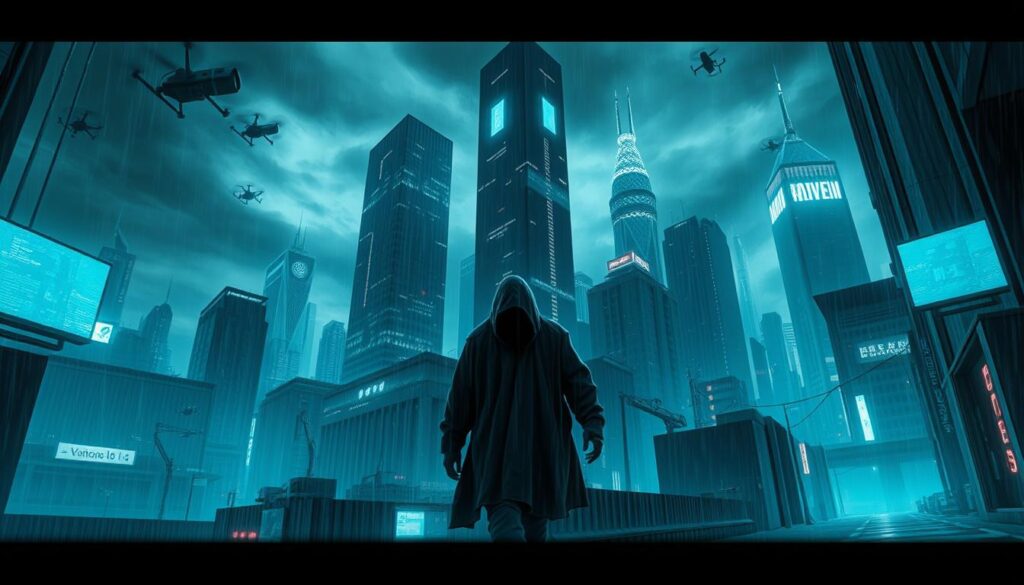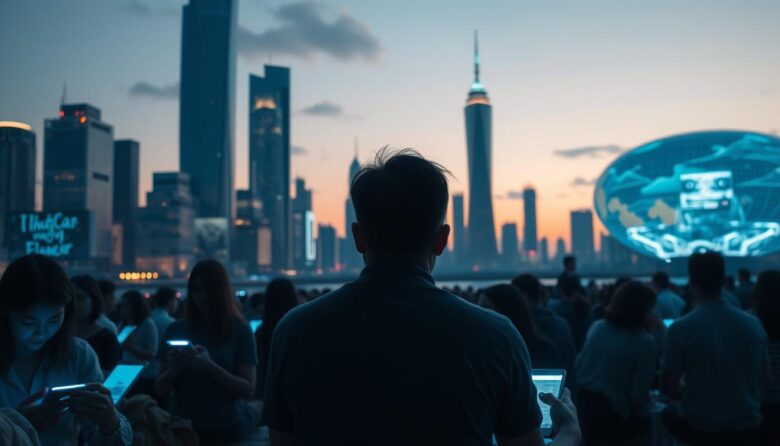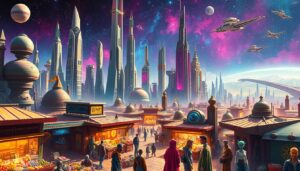Sci-fi stories often look at how technology affects our relationships. They ask if tech can bring us closer or push us apart. This article explores the impact of technology on human connection in sci-fi narratives, showing how stories envision our future.
Shows like Black Mirror and films like Her show how tech changes love, trust, and how we talk to each other. These stories don’t just predict new gadgets—they question what it means to be human in a world full of technology. Each story reflects our hopes and fears about technology’s role in our lives.
Why does this matter? Sci-fi isn’t just for fun—it helps us understand today’s tech trends. As gadgets like VR headsets and chatbots become more common, these stories warn and inspire us. They make us think: How do devices affect our real-world connections?
Key Takeaways
- Sci-fi highlights how tech reshapes personal bonds through imaginative stories.
- Stories like Her and Black Mirrorexplore both the good and bad sides of tech’s influence.
- These narratives reflect real-world debates about privacy, AI ethics, and social media’s effects.
- Sci-fi’s themes help audiences consider the balance between innovation and human needs.
- Understanding these tales offers insights into our own tech-driven relationships today.
Introduction to Technology and Connection in Sci-Fi
Sci-fi stories often explore how technology shapes relationships. Let’s break down core ideas to better understand this blend of innovation and emotion.
Defining Key Terms
Start with basics: technology in sci-fi refers to futuristic tools like AI or VR. Human connection means bonds between characters. These terms form the story’s foundation.
- Technology: Devices and systems imagined for future worlds
- Connection: Emotional ties, trust, and communication between beings
Importance of Human Connection
“The human heart is the final frontier.” — Star Trek episode “Loud as a Whisper
Stories like Her (a movie about AI romance) show how tech can mirror real emotions. Without connection, even advanced tech feels empty.
Overview of Sci-Fi as a Genre
| Classic Sci-Fi | Modern Sci-Fi |
|---|---|
| 2001: A Space Odyssey (1968) | Black Mirror (2011–present) |
| Focused on space exploration | Explores digital age dilemmas |
| Robots as tools | AI as moral mirrors |
Sci-fi’s evolution shows how technology in sci-fi now often asks: Does tech bring people closer—or push them apart?
Historical Context of Technology in Sci-Fi
Sci-fi has always explored human connection in sci-fi, even before today’s tech. Authors like Mary Shelley and H.G. Wells imagined inventions that made us question our relationship with progress. Their stories warned of isolation and ethical dilemmas, setting the stage for future debates.
Early Predictions of Technological Impact
From the 1800s to the early 1900s, stories saw tech as a disruptor. Shelley’s Frankenstein (1818) asked if creators should be responsible for their creations. Later, Karel Čapek’s 1920 play R.U.R. introduced “robots,” sparking debates about labor and humanity’s role.
Evolution of Sci-Fi Narratives
Over time, sci-fi evolved from dystopian warnings to nuanced explorations. Themes like AI ethics and digital communication became central. Writers like Isaac Asimov and Philip K. Dick explored how tech reshapes trust, empathy, and identity—key to human connection in sci-fi.
Critical Sci-Fi Works That Shaped the Genre
| Work | Year | Connection Themes |
|---|---|---|
| 1984 (Orwell) | 1949 | Surveillance vs. personal bonds |
| Blade Runner | 1982 | Identity and artificial life |
| Neuromancer | 1984 | Cyberspace vs. real-world ties |
“The function of sci-fi is to humanize technology.” — Ursula K. Le Guin
These stories are still vital today. They reflect our current worries about AI and social media. By revisiting these narratives, we see how sci-fi’s core—human connection in sci-fi—has remained relevant for centuries.
The Role of AI in Sci-Fi Narratives
Sci-fi stories often explore how artificial intelligence challenges our understanding of companionship and ethics. Films like Her and Ex Machina show AI companions designed to mimic human emotions. They raise questions about what it means to form bonds with technology.

AI as Companions
Popular narratives highlight AI companions that blur lines between code and kinship. Examples include:
- Her: A man falls in love with an AI operating system.
- Blade Runner 2049: Replicants seek recognition as sentient beings.
- Westworld
: Hosts question their roles as servants versus equals.
Moral Dilemmas in Human-AI Relationships
Stories often ask: Can machines deserve love or rights? This tension mirrors real-world debates about ethics in AI development. Consider the quote:
“If we design AI to need us, do we become caretakers or users?”
| Story | Moral Question |
|---|---|
| Ex Machina | Can AI experience true autonomy? |
| I, Robot | Should humans trust AI decisions over human judgment? |
These tales reflect fears and hopes about the technology impact on human relationships. As AI evolves, sci-fi reminds us to ask: How do we balance innovation with humanity’s core values?
Virtual Reality and Its Impact on Interpersonal Relationships
Sci-fi stories often look at how virtual reality (VR) changes how we connect. They ask if VR can bring us closer or drive us apart.
Escapism and Isolation
In Ready Player One, VR is a way to escape real-life problems. But, it can also lead to ignoring the world outside. Characters who get too caught up in VR show us the dangers of too much screen time.
An episode of Black Mirror shows how VR can make friends seem like just data.
User Agency versus Real Life
VR lets users control their digital world in ways we can’t in real life. But, sci-fi wonders if this control hinders our growth as humans. It asks if winning virtual debates is the same as real connection.
- Pros: VR can create global communities and help us understand others better.
- Cons: Relying too much on VR might make us less emotionally connected, turning relationships into just code.
Sci-fi stories show a big question: Can VR really connect us, or does it make us miss out on real human touch? They remind us that true connections happen in the real world, not just online.
Augmented Reality in Sci-Fi Stories
Sci-fi explores how augmented reality (AR) changes our experiences. It mixes the real and digital worlds. Stories show AR as a way to deepen connections, not replace them.
Authors imagine futures where people see hidden data or share virtual spaces. Yet, they stay connected to the physical world.
Merging the Physical and Digital Worlds
Neal Stephenson’s *Snow Crash* introduces AR goggles that add text and images to streets. This turns cities into interactive maps. It doesn’t erase reality but makes it smarter.
Characters can read menus or decode symbols in real time. This makes the world feel richer, not isolating. Stories highlight AR’s value in enhancing, not replacing, everyday life.
Enhancing Human Interactions
In *Ghost in the Shell*, agents use AR to share perspectives during missions. This turns solo tasks into teamwork. It lets people see through each other’s eyes, building trust.
Plots suggest AR could improve collaboration, not just solo screen time. These tales ask: Can digital layers make face-to-face conversations more meaningful?
Dystopian Futures: Technology and Alienation
Sci-fi stories often show how technology can break human connections. Movies like Blade Runner and books like Neuromancer paint pictures of worlds where people feel alone, even with all the progress. They caution that the tools meant to bring us together can actually push us apart.

Common Themes in Dystopian Sci-Fi
- Overreliance on AI causing emotional detachment
- Mass surveillance reducing personal freedom
- Technological divides between social classes
Shows like Black Mirror reveal how social media and data collection can warp our view of reality. In 1984, telescreens represent how technology can crush real human connection.
Utopian vs. Dystopian Outcomes
Authors explore both bright futures and dark ones. Star Trek dreams of a world where technology unites us, while The Matrix depicts a world where machines control our minds. This contrast makes us wonder: Can we move forward without losing touch with each other?
“The future isn’t about gadgets—it’s about the choices we make with them.” — Asimov-inspired sentiment
Sci-fi teaches us that the future is not predetermined. Every new technology or invention has the power to bring us together or drive us apart. The genre urges us to think about the choices we make and their impact on our world.
Technology as a Bridge to Connection
Sci-fi isn’t all about doom and gloom. Many stories see technological advancement in sci-fi as ways to connect people. They imagine tech like instant translators and holographic networks bringing us closer, not pushing us apart.
Global Communication in Sci-Fi
Stories like Arrival and Star Trek show tech breaking down barriers. Imagine a world where language no longer divides:
- In Arrival, alien language tech changes how humans see time, building empathy across cultures.
- Star Trek’s universal translator turns misunderstandings into dialogue, uniting alien species.
Stories That Highlight Unity Over Division
“Infinite diversity in infinite combinations.” – Vulcan Philosophy in Star Trek
Stories like Her show AI creating emotional bonds, while Children of Men uses shared tech struggles to highlight human solidarity. These narratives prove that technological advancement in sci-fi can spark empathy, not isolation.
- Her explores love between a man and AI, showing emotional bonds beyond biology.
- In Star Trek: Discovery, alien tech forces warring factions to collaborate, proving unity beats conflict.
Reimagining Human Relationships Through Technology
Sci-fi stories often explore how technology changes human bonds. They ask if machines can feel and if upgrades erase our humanity.
Humans and Cyborgs: Redefining Connection
In stories like Ghost in the Shell and Blade Runner, cyborgs seek acceptance. They make us wonder what makes a relationship “real” when one partner is part machine.
| Work | Key Interaction | Implication |
|---|---|---|
| Ghost in the Shell | Cyborg police unit | Showcases trust between human leaders and enhanced agents |
| Blade Runner 2049 | Replicant-Karen | Asks if synthetic beings can love and be loved |
Emotional Depth in Technological Interactions
Modern films like Her and Ex Machina delve into emotional bonds:
- Her’s romance with AI highlights digital age isolation.
- Ex Machina’s climax shows AI’s emotional depth surpasses its creator’s.
These stories show technology can deepen empathy or reveal our limits. They challenge us to value authenticity in our tech-driven world.
The Future Landscape of Human Connection
Modern sci-fi stories paint vivid pictures of tomorrow’s world. Writers today imagine how tech might shape relationships, offering both hope and cautionary tales. Let’s explore these visions and what they mean for us.
Predictions in Modern Sci-Fi Works
Recent films and books suggest three trends:
- Neural networks enabling direct brain-to-brain communication (like in Upgrade).
- AI companions becoming family figures, as seen in Her.
- Global “digital villages” where cultures merge virtually, inspired by Ready Player One.
The Role of Emerging Technologies
Emerging tools could redefine how we interact. Consider this:
| Technology | Potential Impact |
|---|---|
| Augmented Reality | Shared virtual spaces for global gatherings |
| Brain-Computer Interfaces | Deeper empathy through emotion-sharing tech |
| Quantum Internet | Instant global communication without lag |
Sci-fi reminds us that progress isn’t just gadgets—it’s how we choose to use them. Will we prioritize bonds over convenience? The next chapter is up to us.
Conclusion: Tech’s Everlasting Impact on Human Connection
Sci-fi stories often talk about how tech changes our connections. They show both the good and bad sides of our digital world. For example, Black Mirror and Her show how tech can make or break relationships, making us think about our choices.
Reflecting on Current Trends
Today, we see these themes in our lives. Social media and smart devices connect us but can also make us feel alone. Sci-fi teaches us to think about how tech like AR glasses or chatbots affect our empathy and trust. It’s important to use tech wisely, so it helps us, not hinders us.
Call to Embrace Meaningful Connections
Even as tech gets better, real connections are still key. Stories tell us that too much screen time can make us miss out on real moments. By choosing to listen, share openly, and value face-to-face talks, we keep our relationships strong. The future is about using tech to enhance, not replace, what makes us human.



